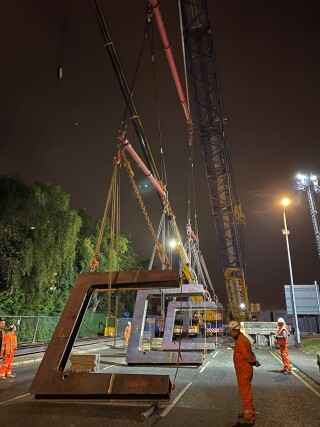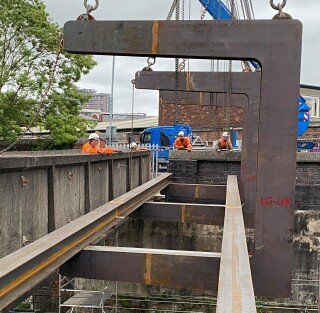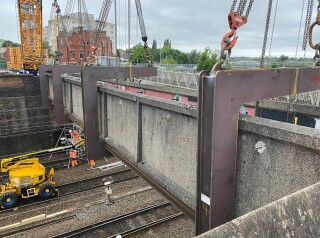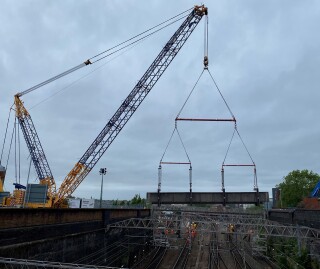Instead of breaking out the concrete footbridge in situ, since it was over a railway line, a series of C-hooks were used in parallel to lift out the bridge in one piece.
A series of four C-hooks were suspended from two spreader bars.
The below-the-hook devices were engineered by Lifting Gear UK for main contractor J Murphy & Sons. The Network Rail bridge was over a main line near Stockport.
Lifting Gear UK operations director Chris Turner came up with the solution. He said: “Conventionally, when carrying out this type of work, it is commonplace for the bridge to be broken up in situ and allowed to fall onto wooden bog mats that protect the railway lines, from where it is then cleared away. But in this case, it was not possible to demolish the structure in-situ due to the presence of multiple sets of overhead line equipment.
“Our solution was to remove the entire 92-tonne bridge in one go, which made it a much quicker and more cost-effective method.”
While C-hooks are commonly used in the steel industry for handling coils, there use in construction and demolition is less comment. Lifting Gear UK worked with its subsidiary Steelwise to create its own hooks, with Steelwise technical manager Alastair Clark and design engineer Will Almond designing, fabricating and testing them before deployment.

Chris Turner said: “Each hook weighs 3.5 tonnes and is capable of lifting up to 25 tonnes, in this case also with 26 metre support beams bolted to the C-hook. This provided complete support for the full length of the footbridge, which was required as the bridge was a pre-tension design.
“The principle behind the idea is relatively simple and was based on how a crane pallet fork works. The challenge for Steelwise was making it work on a much bigger scale.”
The C-Hooks were deployed to the Stockport site in May of 2020 using a 600-tonne class Demag CC2800 crawler crane supplied by Ainscough Crane Hire Limited and the bridge removal was completed within a weekend possession, providing minimal disruption to the railway line and surrounding roads.
Got a story? Email news@theconstructionindex.co.uk






